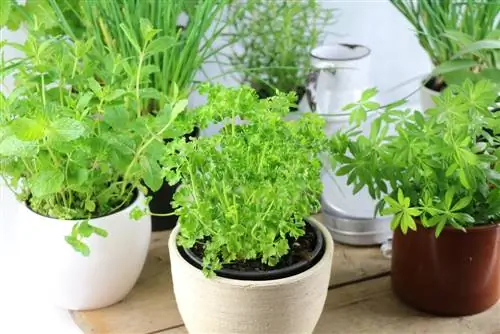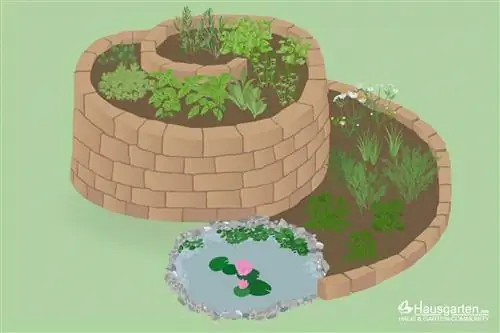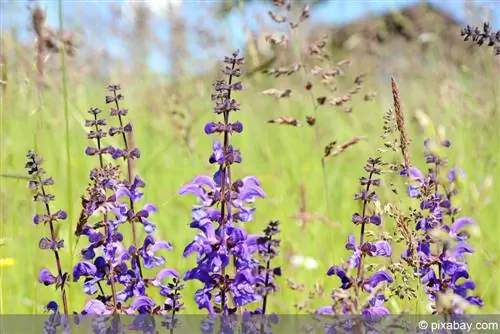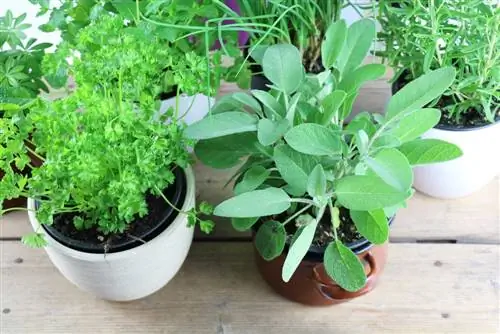- Author admin [email protected].
- Public 2023-12-17 03:39.
- Last modified 2025-01-24 12:45.
Many hobby gardeners and herb gardeners have their little herb paradise on their balcony at home. Not only do they always have aromatic plants for cooking or he alth, but they also have a fragrant environment that provides a valuable source of food for many beneficial insects in spring and summer. However, if you want to grow herbs on your balcony, you should first think about the location and know which herbs are suitable.
Location
Finding the right location for the herbs is actually quite easy: you just have to experience the conditions in which the herbs originally grow. Mediterranean herbs such as thyme and rosemary need a lot of sun and warm temperatures, while native plants usually cope well with partial shade and also survive cooler nights without any problems. If an herb grows under tall trees in a shady forest, it is also suitable for low-light places on a balcony. These should then be a little moister. Only plant herbs together that match each other's needs. Please note:
- Light requirements
- Heat tolerance
- Drought resistance
- Water requirements
- Nutrient requirements
Location of the balcony
Before you simply buy herbs to your heart's content or cultivate them yourself from seeds, you need to clarify what location your balcony is. Depending on the orientation, the hours of sunshine and therefore the incidence of light and the temperatures differ enormously.
South facing
Of course, a south-facing balcony should be very popular - as far as hours of sunshine are concerned - as long as other buildings or large trees don't block the sun. For the gardener, a south-facing balcony means that a variety of plants can be grown, but they require increased care due to frequent watering. However, very few herbs can tolerate full sun all day, so a shady spot should always be created to protect sensitive plants from the sun during the midday hours.
North facing
In contrast to a south-facing balcony, you can expect the lowest amount of sunshine on the north side of the house. But even hobby gardeners with north-facing balconies don't have to go without herbs, even if their selection is significantly limited. Since the water evaporates much more slowly here, frequent watering is not necessary. Watering the plants should be done in the morning so that the substrate is not too wet at night and thus promotes waterlogging or mold formation.
West or East side
All herbs that love partially shaded locations feel comfortable in these locations. If the development is relatively free, a west-facing balcony usually has a little more light than the east-facing variant. In most cases the light/shadow ratio is optimal, although the west-facing balconies have a slightly higher solar yield and temperatures.
Planters
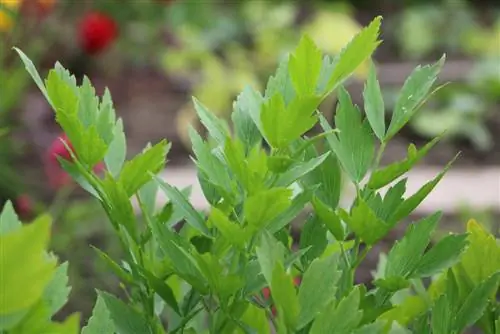
For the herb garden on the balcony you also need appropriate planters. In addition to the obligatory balcony box, a variety of plant pots or buckets are used. For some herbs, it is important that the pots are of appropriate depth, because dill and lovage form deep roots. Shallow planters would inhibit the growth of these herbs or require increased care. Allow at least 15 cm of space per plant; very large varieties should be grown alone in a pot.
- Balcony box
- Individual pots (possibly a shelf or special herb pot holder for the wall)
- Bucket
- Herb spirals/herb towers for the balcony
- Plant pot stand
If you are thinking about purchasing a herb spiral, you have to think about its structure and the individual planting zones.
Substrate
Usually normal potting soil or commercial herb soil is used to cultivate herbs on the balcony, which usually consists of humus, peat and fertilizers. Such substrates can be used well for many herbs, but some have special requirements for their substrate. Mediterranean herbs require sandy and very well-drained soil and should therefore not have to grow in normal potting soil. Moisture-loving plants on the north-facing balcony, on the other hand, have no problems with herbal soil.
- sandy, low-nutrient and humus-rich substrates (up to 35% sand): for Mediterranean herbs
- alternatively, commercially available Mediterranean potting soil or citrus plant soil for lime-tolerant plants
- Herbal soil: local herbs for partial shade and shaded areas
- alternatively loamy-humous soils with a small amount of sand (10-15%) made from bark humus, compost and sand
Potting soil containing peat should be mixed with sand, pumice, lava granules or zeolite in advance for better ventilation. The amount depends on the type of plant. Thyme, sage and rosemary contain up to 35% of such additives. Tarragon, dill or lemon balm require around 15% of the mineral component.
Tip:
Substrates containing peat are not only not very environmentally friendly, they also naturally contain few nutrients and tend to dry out quickly. So it's better to use a mixture of humus and compost.
Not suitable for the balcony
All herbs that form very pronounced rhizomes are generally not well suited to cultivation in a flower pot. The cramped conditions do not allow the plants to grow optimally, so the hobby gardener doesn't get much enjoyment out of them. These include:
- Valerian
- Curry herb
- Tarragon
- Eberraute
- Pimpinelle
- Meadowsweet
- Wormwood
If you still want to grow these herbs, you should provide them with a large pot in isolation.
Tip:
There are herbs that are particularly susceptible to aphids or other parasites. This includes, for example, borage. If you don't get the lice under control, all other plants can also become infected.
Suitable herbs
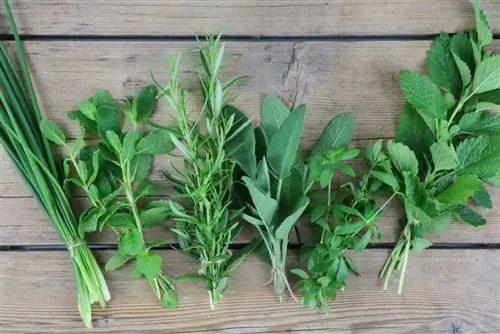
First, get an overview of which herbs can be grown on which side of the house. It is helpful to know which plants prefer or tolerate sunny, partially shaded or even shady locations.
Herbs for the south-facing balcony (full sun)
In addition to the usual Mediterranean herbs, plants that like semi-shady locations can also be grown here. However, make sure that these herbs are protected from the midday sun. You can do this, for example, with a sun sail or other shading options. It is also possible to position more sensitive species not at the top of the balcony in a balcony box, but at the bottom on the ground. This way the herbs still receive enough light, but are not in danger of burning. The following plants are suitable for locations in full sun:
Annual and biennial herbs
- Basil: the warmer and sunnier, the better, soil is more nutrient-rich with sand content
- Borage: Deep-rooted, requires nutrient-poor but rather moist soil
- Dill: deep roots, nutrient-rich, loose soil
- Chamomile: neutral to calcareous soil, rather nutrient-poor and dry
- Chervil: nutrient-rich, humus-rich, but very well-drained substrates
- Coriander: calcareous, moderately nutrient-rich and dry soils
- Cumin: medium nutrient-rich, humus, rather moist
Perennial Herbs
- Savory: nutrient-poor, permeable substrates
- Marjoram: Shallow roots, calcareous soil, loose and low in nutrients
- Oregano: calcareous, loose and low in nutrients
- Rosemary: deep roots, nutrient-poor and permeable soil
- Sage: sandy and low in nutrients
- Sorrel: Shallow roots, nutrient-rich and rather moist
- Thyme: Shallow roots, nutrient-poor and permeable soils
- Lemon balm: shallow roots, loose and nutrient-rich
Herbs for east and west balconies (partial shade)
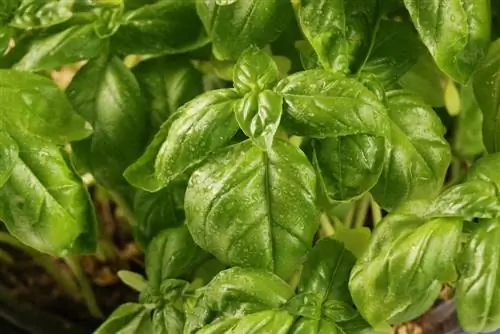
Both the east and west sides of the house generally have good location conditions for plants that prefer semi-shady locations. This means at least four to six hours of sun, but not at midday. West balconies are more similar to south balcony conditions, east balconies are a little shady and cooler. That's why plants for shade can easily be grown in an east-facing location, while Mediterranean plants thrive on a west-facing balcony. Plants for partial shade:
Annual or biennial herbs
- Basil: more like a west-facing balcony, nutrient-rich, loose soil
- Borage: deep-rooted, low in nutrients and loose, rather moist
- Dill: deep roots, nutrient-rich, permeable substrates
- Nasturtium: (annual and perennial varieties) very humic, slightly moist
- Chervil: humus-rich and nutrient-rich soil, well-drained for water
- Parsley: deep roots, nutrient-rich, loose soil
Perennial Herbs
- Savory: west-facing balcony, nutrient-poor and permeable soils
- Lovage: loamy-humus soils, nutrient-rich and slightly calcareous
- Marjoram: Shallow roots, calcareous soil, loose and low in nutrients
- Oregano: shallow-rooted, calcareous, loose and rather nutrient-poor soil
- Peppermint: nutrient-rich and loose, very vigorous, so it is better to cultivate it individually
- Rosemary: West-facing balcony, deep roots, nutrient-poor, permeable soil
- Sage: West-facing balcony, nutrient-poor, sandy substrates
- Sorrel: Shallow roots, moist, nutrient-rich soil
- Chives: permeable, humus-rich soil, moist and fresh
- Thyme: shallow roots, permeable and nutrient-poor substrates
- Lemon balm: Shallow roots, nutrient-rich and loose
Herbs for north balconies
Herbs also grow on a north-facing balcony. Just not all varieties. Anyone who specializes in forest herbs such as wild garlic can also harvest diligently. But here, too, it doesn't work completely without light. In order for plants to grow at all, the balcony needs at least two to three hours of sunshine a day. If this is not guaranteed, even the most shade-tolerant plant will have difficulty growing sufficiently well here. All herbs mentioned are perennials.
- Wild garlic: nutrient-rich, loose soil, preferably calcareous
- Watercress: (perennial, but is usually grown as an annual) nutrient-rich, moist substrate
- Garlic mustard: deep-rooted, nutrient-rich and fluffy
- Lungwort: humus, rather moist (but well-drained)
- Peppermint: nutrient-rich and loose, very vigorous, so it is better to cultivate it individually
- Woodruff: fresh to moderately moist, humus-rich soil, calcareous
Since shade herbs generally prefer moist locations, they should be watered heavily.
Which herbs don’t go together?
First of all, only those herbs that prefer similar location and soil conditions should be cultivated together in a planter. It also makes sense not to cultivate strong-growing plants such as mint with weak or low-growing herbs, otherwise the weaker plant will be crowded out. In addition, there are herbs that complement each other well, while others do not get along without consequences. Don't match:
- Plants with very different location and soil requirements
- If possible, do not plant annual herbs together with perennials
- Basil with lemon balm and dill
- Coriander and fennel
- Dill is not self-compatible and does not go well with fennel and caraway
- Peppermint and Chamomile
- Marjoram and thyme
- Coriander does not go well with parsley, chives and chervil
Planting Examples
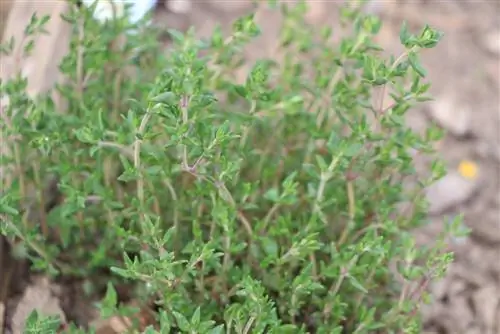
In terms of their location, soil conditions, water and nutrient requirements, the following herbs fit particularly well together in one pot:
South and west balcony
- Sage, thyme and basil (sandy-humus soil, moderately nutrient-rich)
- Rosemary, thyme, sage, oregano (sandy soil, low in nutrients)
- Thyme, chervil, rosemary (sandy-loamy soil, rather poor in nutrients)
- Borage, dill and sorrel (moderately nutrient-rich, rather moist soil)
- Basil, chervil, sorrel (nutrient-rich, rather moist)
- Marjoram, chamomile and oregano (calcareous, very sandy soil, little water)
- Lemon thyme, savory, rosemary as perennial herbs for dry, barren soils
- Savory, marjoram, rosemary, sage (sandy, nutrient-poor soils, tolerate drought)
West or East balcony
- Borage, lemon balm, chives, dill (deep pot, sandy-humous soil)
- Coriander, marjoram, chamomile and oregano (calcareous, nutrient-poor and sandy substrates)
- Caraway, lemon balm and borage (moderately nutrient-rich, humic and rather moist)
- perennial herb pot: lemon thyme, savory, rosemary for dry, barren soils
- tried and tested culinary herbs: parsley, chives and caraway (medium nutrient-rich, humus, rather moist, deep pot)
- for soups: marjoram, parsley, borage and chervil (light, humus-rich soil, moderately moist)
- Thyme, sage, chives, lemon balm (humic-sandy soil, moderately moist)
North to Northeast
- Wild garlic, garlic mustard and woodruff (nutrient-rich, moist and slightly calcareous)
- Chives, lemon balm and wild garlic (humous and slightly moist)
- Mint and lemon balm (tolerate almost all soils, moderately moist)
Care

While it is advisable to buy perennial herbs from specialist retailers, annual plants can be grown from seeds on the windowsill every year around the end of March to mid-April. Kitchen herbs from the supermarket are not recommended for cultivation on the balcony because they were grown for short-term consumption. Herbs do not require high amounts of nutrients, so annual plants do not need additional fertilization when using good soil. It is best to provide perennial plants with a slow-release fertilizer at the beginning of the growing season. The need for water depends on the location and the respective type of herb.
Herbs in winter
Annual herbs must be replanted or sown every spring as they only last one summer. However, some aromatic plants are biennial or perennial. Frost-hardy, local herbs can therefore be covered with some leaves or straw in autumn and overwintered in a protected place on the balcony. Mediterranean plants need to be kept indoors during the cold season. They should be placed in a very bright location and, if possible, not placed directly above a radiator. A slightly cooler place around 15-18 degrees protects the herbs from pest infestation. From mid-May, the herb pot can be permanently placed outdoors again.
Conclusion
Choosing the right herbs for a balcony is very easy. Mediterranean herbs grow best on a sunny, south-facing balcony and need to be kept dry. Native garden herbs do well on a partially shaded east or west balcony and thrive in humus-rich, moist, fresh soil, while on the shady north side, plants that naturally thrive in forests thrive. With a few exceptions, you can plant all herbs with similar requirements together.

